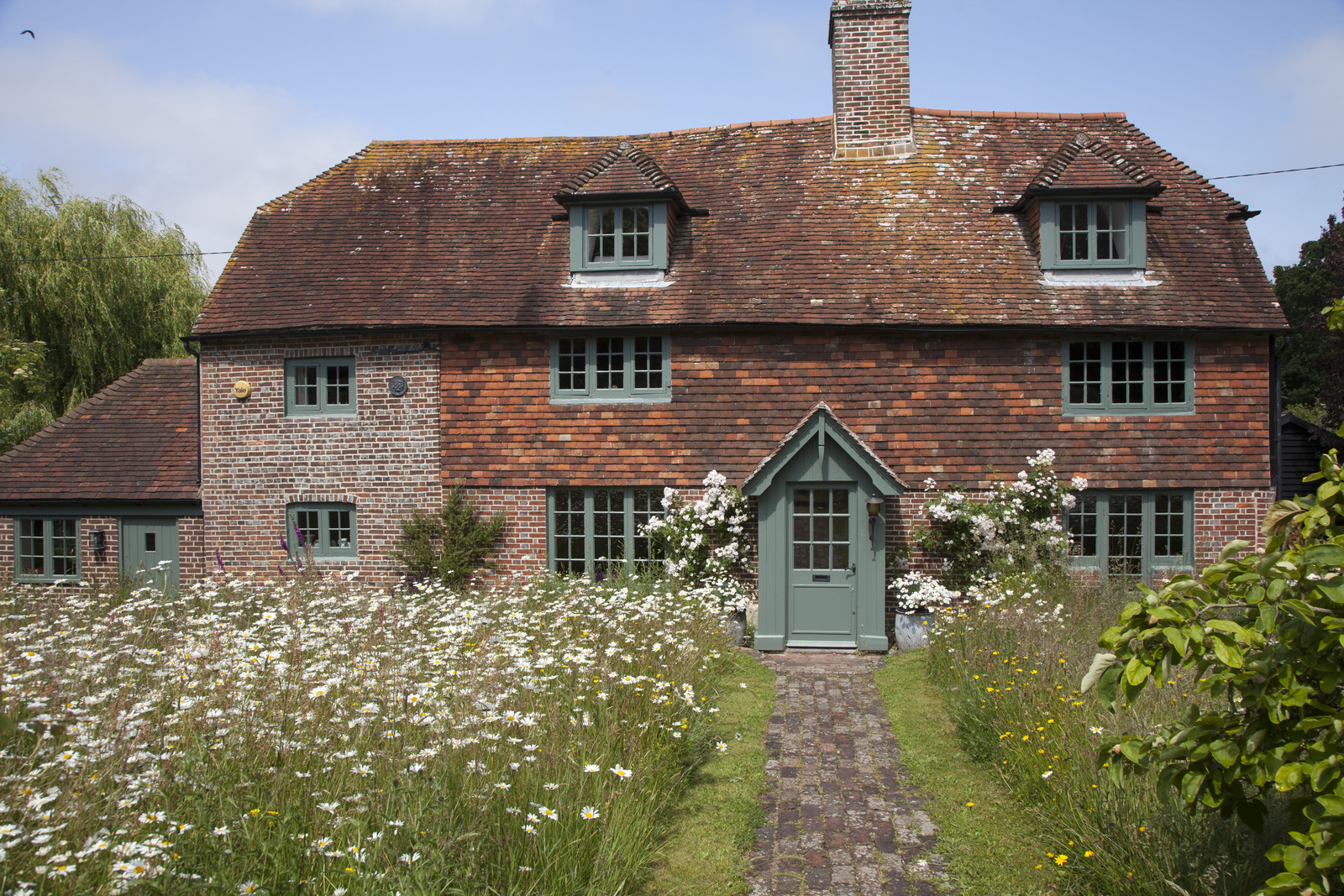
Pett, East Sussex£1,500,000 Freehold
Interlocking living spaces are at once sociable and intimate, with windows that face out to the arresting gardens on each aspect
A remarkable 17th-century farmhouse forms the architectural basis of this handsome home in Pett, East Sussex. Both inside and out, a wealth of period features remain in situ, added to by a set of 17th and 18th-century installations including a wonderful inglenook fireplace and a winder staircase with an exquisite octagonal newel post. Set across three storeys, the primary plan encompasses five bedrooms and a set of atmospheric living spaces arranged in a circular, cohesive configuration. There is also a one-bedroom annexe and a series of outbuildings used as a workshop, a utility room, and a party room. Spanning some two and a half acres, the grounds are nothing short of spectacular, filled with mature trees and seasonal flowers, and home to wildflower meadows and a Mediterranean-inspired courtyard.
Setting the Scene
French Court Farmhouse was built circa 1640, but its name predates the Norman Conquest. Only here has the ancient name survived of a local manor (Frensshecurt, or Frenkiscourt, now largely Fairlight) given by Edward The Confessor to an abbey in Fecamp. It is possible It is possible that a farmhouse of some sort stood on this site in the mid-11th century.
The house was added to in the 18th century, when its footprint was expanded. The original section of the house was constructed with handsome Flemish bond brickwork, while the rear uses the English bond variety. Inside is a bounty of striking period features, from floorboards and doors to windows and beams.
Fairlight Hall was later sold off in sections in 1917; at this time, it was referred to as “a very fertile dairy, market garden and hop farm”. Remarkably, author C.S. Lewis recorded taking lodgings in French Court Farmhouse, writing that: “The hausfrau, Miss Carne, is rather an old maid but feeds you excellently; she is very mean about firing, but contrariwise you have permission to gather firewood for yourself in the woods behind the house […] mystically incorporating you from mere tripper-hood into the body of rural life […] the cottage is beautiful. The wood is heavenly.” (from ‘C.S. Lewis, My Godfather’ by Laurence Harwood).
The Grand Tour
French Court Farmhouse is reached via an old farm track, an approach that amplifies its sequestered, pastoral feel. A charming ruddy façade greets on arrival, peering above the wildflower-filled front garden. A brick-laid path guides towards the front door and porch, which, as with the windows, is painted in a soft, muted green shade.
The primary point of access is to a hallway, although alternative entrances lead directly to the kitchen or to one of two living rooms. On the left is the first sitting room, a cosy, comfortable space with oak floorboards underfoot and a large inglenook fire, now fitted within an Aga wood-burner. Beams and posts are left uncovered, their deep hue providing an evocative backdrop.
A door opens to the dining room, a similarly atmospheric space bookended by windows that look out to either garden. There is plenty of room here for a large table and chairs – apt for seasonal festivities or ambient, candle-lit dinners. Cast-iron radiators are also fitted here and throughout.
The kitchen is beyond, within an extension added by the current owners; it was built in the local vernacular, using local handmade bricks. An angled roof above creates an exaggerated sense of volume and is studded with skylights that draw in light. Colour is used sparingly here, but to wonderful effect: navy-blue units contrast with oak countertops and mustard-yellow feature walls. Appliances include a Mercury range and a Siemens fridge/freezer, and there is a deep sink set beneath a trio of casement windows. At the far end is a door to the outside, next to a set of shelves affixed to a textured, exposed brick wall.
At the rear of the dining room is a door to the back hall and boot room, with another door to the outdoors. From here is a bright bathroom with a roll-top tub and fixtures from Thomas Crapper. Beyond is the second reception space, at the front left of the hall; once the original parlour, it has a curved brick, 18th-century fireplace with a timber lintel and another wood-burning stove.
An 18th-century winder staircase ascends to the first floor, where three bedrooms lie. The principal is especially characterful, with fitted cupboards, 17th-century oak floorboards, ‘London Clay’-painted walls and an adjoining WC. The second bedroom also features 17th-century oak floorboards and fitted wardrobes, plus 18th-century tongue and groove panelling. There is also a smaller bedroom on this level, which would make for a wonderful dressing area or study, and a shower room with a walk-in shower and an Albion basin.
A Sussex Y staircase leads to two double bedrooms on the second floor, all picked out in rich paint colours from Farrow and Ball. One has an anteroom and plenty of storage space in the eaves.
Set above the barn, a one-bedroom annexe is well-equipped with a serene bedroom and smart shower room – a wonderful retreat for visiting guests or elderly relatives. It has its own dry shingle garden closed by woven chestnut fencing.
The Great Outdoors
Romantic gardens spanning some two and a half acres emanate from French Court Farmhouse, cleverly delineated by its current owners. The grounds comprise gardens, wildflower meadows, an orchard, a paddock, woodland and a natural wild pond at the end of the boundary. Large swathes have been left natural and semi-wild to encourage wildlife; regular visitors include buzzards.
The meadows are full of wildflowers beginning with cowslips, snakeshead fritillaries in spring, then common spotted orchid, yellow rattle and oxeye daisies. There are also plenty of mature trees, including a quince, medlar, acer and an unusual snowdrop tree.
A Mediterranean courtyard has an olive tree, lavender, and mature yew and box topiary all around an antique stone horse trough repurposed as a bubbling water feature. There are late-flowering perennial borders which go through from May to stand all winter.
A quiet green and white garden enclosed by yew hedging is the setting for a reflective pool – the ideal spot for yoga or meditation. On one side is the ‘big meadow’, where mown paths lead towards the summerhouse. An orchard is ripe with productive apple trees, and there is a walled kitchen/cutting garden with the likes of asparagus, fig, rhubarb and gooseberries.
There is also a set of ancillary buildings, including a barn, currently used as a workshop, as well as a utility space and a separate studio/workshop/occasional party room.
Out and About
Pett is immersed in the East Sussex countryside, yet sits just a few minutes’ drive from the coast. The village sits perched atop a high ridge in the valley, with fantastic views of the gently undulating landscape.
Despite its sequestered feel, the house is within easy reach of two excellent pubs in Pett, The Two Sawyers and The Royal Oak, along with a village hall that hosts a lively programme of events. The wonderful Old Butcher’s Shop is a 15-minute walk from the house and provides locally sourced meat and produce.
Pett Level is the village’s coastal twin, and its wonderful beach is just a six-minute drive from the house. The area is great for swimming, with a sandy cove stretching towards Winchelsea and Rye Harbour. For walking, the Saxon Shore Way footpath (running from Gravesend in Kent to Hastings) is easily accessible, and there are spectacular walks along the Jurassic Coast across the Rye Harbour Nature Reserve. There is also The Ship, a wonderful deli, café, bar and butcher all in one.
The thriving towns of Hastings and St Leonards-on-Sea are a short drive away, with lively art and food scenes. Hastings Old Town is home to some legendary antique traders and independent retailers, including AG Hendy and Co, Warp and Weft, Hawk & Dove, Vintage Bird, Robert’s Rummage and Hastings Antiques Warehouse. Art galleries are likewise abundant; the most significant is perhaps Hastings Contemporary (formerly the Jerwood Gallery) designed by HAT Projects, though there are many others of note, including The Rebel Gallery.
Hastings is also a brilliant foothold to explore other coastal spots and characterful towns. St Leonard’s, Rye, Camber and Dungeness are all easily reached by car.
There are state-run schools in the villages that surround Pett and in Hastings, along with private options like Buckswood School, Claremont School and Battle Abbey School.
Three Oaks rail station is a nine-minute drive from the house. From here, branch-line rail services to Ashford offer high-speed connections to London St Pancras, with a total journey time of around 90 minutes. Hastings rail station is an 18-minute drive away and offers direct services to London Victoria and London Bridge.
Council Tax Band: G
Please note that all areas, measurements and distances given in these particulars are approximate and rounded. The text, photographs and floor plans are for general guidance only. Inigo has not tested any services, appliances or specific fittings — prospective purchasers are advised to inspect the property themselves. All fixtures, fittings and furniture not specifically itemised within these particulars are deemed removable by the vendor.
French Court Farmhouse — Pett, East Sussex
Interested? Let’s talk
Interested? Let’s talk
Related Listings
- A Home with a History: inside Simon Costin’s Cornish longhouse, where ghosts, dreams and folklore collide
- Past Lives: five unusual conversions steeped in history
- A Garden with a History: a quiet inheritance, tenderly reimagined by designer Tom Faulkner
- Salt and Stone: seven stunning seaside homes in the South West
- A Private View: from relic to ruin to renewal — inside SPAB’s seven-year rescue of St Andrew’s Chapel

